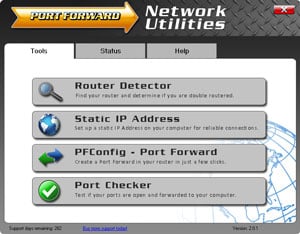Your VR2800 v1 router helps to protect your network by blocking incoming internet connections. This is an important feature that helps you to control which applications have access to your network. Sometimes you want to allow network access to a specific application in order to play a game, connect a device, or use an app. The TP-Link VR2800 v1 can unblock certain incoming connections through port forwarding or by opening a port. You can open ports in your VR2800 v1 by assigning specific ports to an IP address. Forwarding these ports directs incoming data to a specific device or application.
In order to open ports in your TP-Link VR2800 v1 router, you need to:
- Set up a static IP address on the computer or device that you are forwarding ports to.
- Log in to your TP-Link VR2800 v1 router.
- Find the Virtual Servers section in your TP-Link VR2800 v1 router.
- Click on the Advanced tab, which is at the top of the screen.
- Click the NAT Forwarding tab, which is at the left of the screen.
- Click on the link that says Virtual Servers.
- Go ahead and create a Virtual Servers entry.
If this sounds difficult, you are not alone. We will walk you through each step in opening a port for the TP-Link VR2800 v1 router.
We think that forwarding a port should be easy. That's why we created Network Utilities. Our software does everything that you need to forward a port.
When you use Network Utilities you get your port forwarded right now!
Step 1
Set up a static IP address in the device that you are forwarding a port to. This is an important step that keeps your ports open even after a reboot, power outage, or another type of device or router disconnect.
-
Recommended - Our free program will setup a static IP address for you.
â Download Network Utilities today!
-
Or follow our Static IP Address guides to setup a static IP address.
After setting up a static ip address on your devices you need to login to your router.
Step 2
Log in to your TP-Link VR2800 v1 router. To log in you will need to use a web browser since the TP-Link VR2800 v1 uses a web interface to access router configurations.
Open up whichever internet browser that you are comfortable with. If you are not sure which one to use, then go ahead and open Chrome, Firefox, or Edge.
To help with confusion, we have simplified this step for you with this link: Login to your VR2800 v1 Router
Once you have opened a web browser, find the address bar which is usually located at the top of the screen. The image below shows an example of this.

Above is an example of what a web browser address bar looks like. Find the address bar in your web browser and type in your router's IP address.
The default IP address for the TP-Link VR2800 v1 router is: 192.168.1.1
Once you have entered your router's IP address in the address bar go ahead and click the enter button on your keyboard. You should see a box like the one shown below.
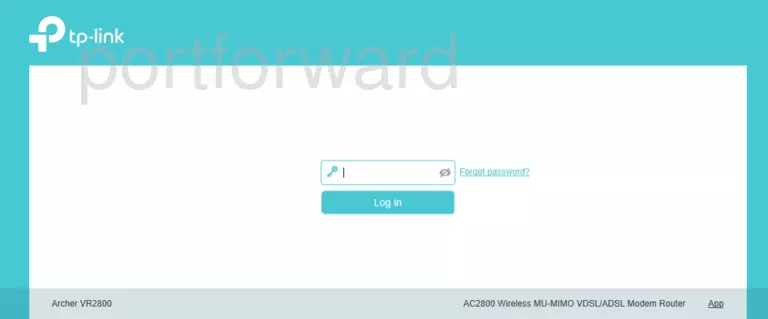
Go ahead and enter the username and password for the TP-Link VR2800 v1 router in the spaces available. Remember if you have changed them in the past, you need to enter those values.
- The default TP-Link VR2800 v1 Router Username is: none
- The default TP-Link VR2800 v1 Router Password is: admin
Enter your username and password, and then click the Log in button to log in to your TP-Link VR2800 v1 router.
TP-Link Username and Password Trouble
If the username and password that you typed in did not work, check out our Default TP-Link Router Passwords page for other ideas about possible passwords.
If, after trying the above list of passwords you still can't log in, you may need to reset your router. Learn how to do that by reading our How to Reset a Router guide. After resetting the TP-Link VR2800 v1 router your username and password are reverted back to factory defaults. Router settings may also change when you reset, so make a note of your current router settings before you reset.
Step 3
You should be on the home page of your TP-Link VR2800 v1 router once you have successfully logged in. Find the Virtual Servers section of your router.
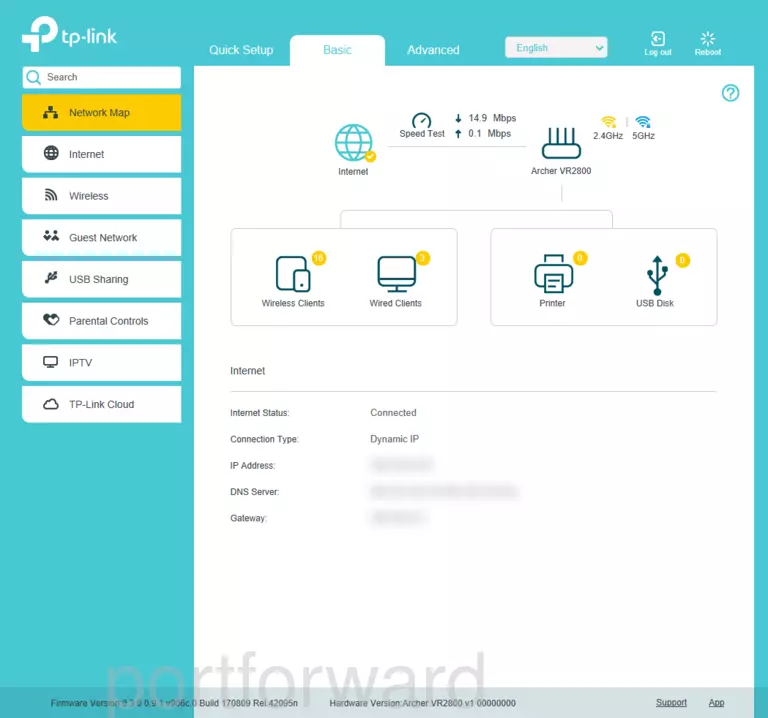
- Click on the Advanced tab, which is at the top of the screen.
- Click on the NAT Forwarding tab at the left of the screen.
- Click the link labeled Virtual Servers.
You are now on the Virtual Servers page.
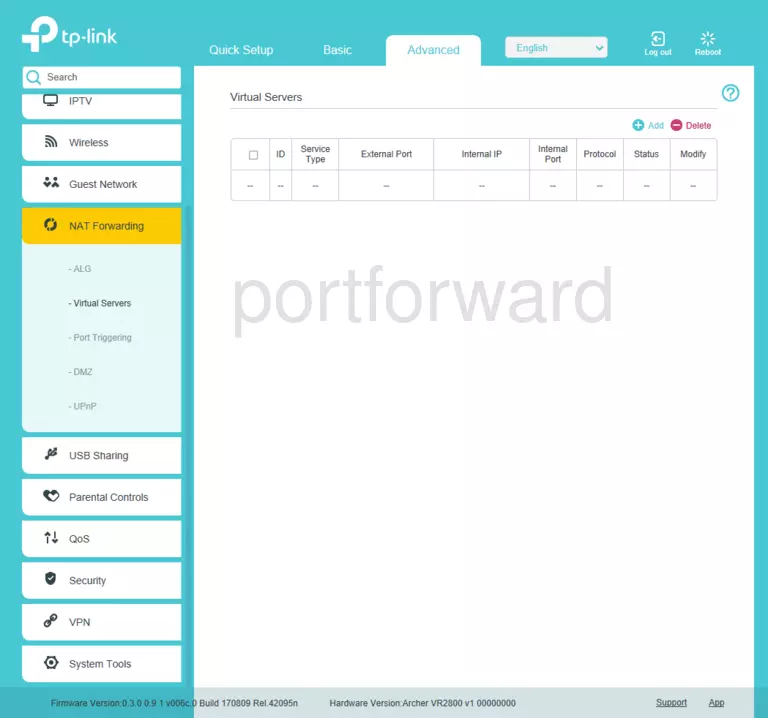
Step 4
Make sure that you must open a port in your router before doing so since this will allow data to come through the firewall portion of your router to a specific device. It is possible that this could lead to malicious traffic on your network. However, don't let this warning stop you from making this change if you need it because the risk is very low.
Here are the ports to forward for Xbox Live:
- TCP Ports: 3074
- UDP Ports: 3074
If you are looking for the ports for a different application you can find it by either:
- Browsing our List of Games
- Check out our our List of Games by Genre
- See our List of all Applications
Don't forget to sign up for NordVPN's promo deal before it's gone.

You might notice that most of our site doesn't have ads on it. This is because we use partnerships with companies like NordVPN to keep the site running. Thank you for supporting us by using our referral links.
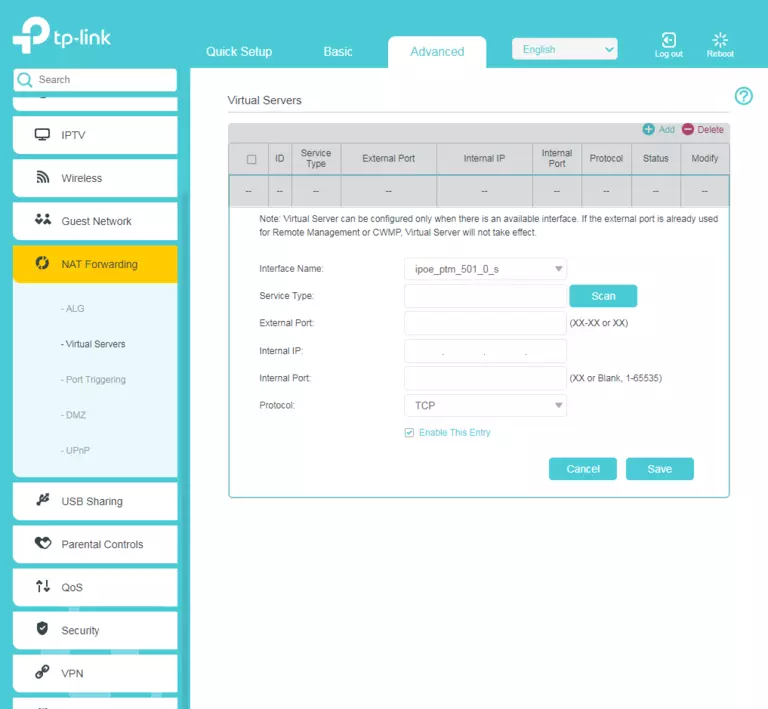
-
Click the Add link at the top of the screen.
-
Choose your internet connection from the Interface Name drop-down list.
-
Put a name for this forward in the Service Type box so that you can remember why you set this forward up. The name does not matter, so pick something that has meaning to you.
-
The External Port box accepts either a single number or a range of numbers. If you are forwarding a single port number, then enter that port number into the External Port box. If you are forwarding a range of ports such as 1000-2000, then you can enter the lowest number of that range into the External Port box, followed by a hyphen, followed by the largest number.
-
In the Internal IP box, enter the IP address that you want ports forwarded to. This may be the IP address of your computer or the IP address of another device on your network that you want to forward ports to.
-
Leave Internal Port blank.
-
Select the protocol type of the ports that you are forwarding from the Protocol dropdown box. If your router has the option of Both, then go ahead and select that. Otherwise, select either TCP or UDP as needed. If you need to forward a port for both TCP and UDP, but your router does not have Both, then you will need to create two entries.
-
Put a check in the box labeled Enable This Entry.
-
When you are completely finished, click the Save button at the bottom of the page to apply these changes.
Test Your Ports To See If They Are Open
Use our Network Utilities software, (which includes a free Open Port Checker tool) to test your network to see if you have forwarded ports in the TP-Link VR2800 v1 router correctly. Open Port Checker is the only online port checking tool that has Guaranteed Results.
Check Out These Helpful Guides:
- Our software called Network Utilities does all of this and more.
- Find detailed tips on how to Setup your router.
- A great list of games and applications that require port forwarding along with their related port numbers.

